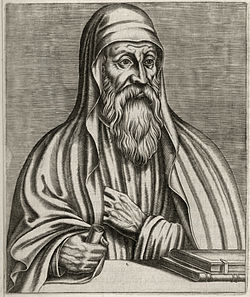Hexapla

Hexapla (Koinē Greek: Ἑξαπλᾶ, lit. 'sixfold'), also called Origenis Hexaplorum, is a critical edition of the Hebrew Bible in six versions, four of them translated into Greek, preserved only in fragments. It was an immense and complex word-for-word comparison of the original Hebrew Scriptures with the Greek Septuagint translation and with other Greek translations. The term especially and generally applies to the edition of the Old Testament compiled by the theologian and scholar Origen sometime before 240.

The subsisting fragments of partial copies have been collected in several editions, that of Frederick Field (1875) being the most fundamental on the basis of Greek and Syrian testimonies. The surviving fragments are now being re-published (with additional materials discovered since Field's edition) by an international group of Septuagint scholars. This work is being carried out as The Hexapla Project under the auspices of the International Organization for Septuagint and Cognate Studies, and directed by Dr Neil McLynn. The members of the editorial board are: Peter J. Gentry (Southern Baptist Theological Seminary and the Göttinger Septuaginta-Unternehmen), Dr Alison G. Salvesen (Oxford University), and Bas ter Haar Romeny (Leiden University).
| Part of a series on |
| Origenism |
|---|
 |
History

Origen began to study Biblical Hebrew in his youth; forced to relocate to Palestine during the persecution of Christianity in Alexandria, he went into biblical textology. By the 240s, he commented on virtually all the Old and New Testament books. His method of working with the biblical text was described in a message to Sextus Julius Africanus (c. 240) and a commentary on the Gospel of Matthew:
Origen, in his Commentary of the Gospel of Matthew, explained the purpose for creating the Hexapla:
Structure

The text of the Hexapla was organized in the form of six columns representing synchronized versions of the same Old Testament text, which placed side by side were the following:
- the Hebrew consonantal text
- the Secunda – the Hebrew text transliterated into Greek characters including vowels
- the translation by Aquila of Sinope into Greek (2nd century)
- the translation by Symmachus the Ebionite into Greek (late 2nd century)
- a recension of the Septuagint, with (1) interpolations to indicate where the Hebrew is not represented in the Septuagint (taken mainly from Theodotion's text and marked with asterisks), and (2) indications, using signs called obeloi (singular: obelos), of where words, phrases, or occasionally larger sections in the Septuagint do not reflect any underlying Hebrew
- the translation by Theodotion into Greek (mid 2nd century)
At the end of his life, Origen prepared a separate work called the Tetrapla (a synoptic set of four Greek translations), placing the Septuagint alongside the translations of Symmachus, Aquila, and Theodotion. Both Hexapla and Tetrapla are found in Greek manuscripts of the Septuagint, as well as manuscripts of the Syro-Hexaplar version. However, in a number of cases, the names of "Hexapla" and "Octapla" (in the Book of Job from the manuscripts of the Syro-Hexapla and the hexaplar Psalms) are also applied to the work of Origen. This caused a discussion in its time about whether these were separate works. According to Eusebius, the Hexapla contained three more translations of the Greek Psalms (Quinta, Sexta and Septima), which, however, have not been preserved (for a total of 9 columns, a so-called Enneapla).
According to Epiphanius of Salamis, the original Hexapla compiled by Origen had eight columns. It included two other anonymous Greek translations, one of which was discovered in wine jars in Jericho during the reign of Caracalla. The so-called "fifth" and "sixth editions" were two other Greek translations supposedly discovered by students outside the towns of Jericho and Nicopolis: these were later added by Origen to his Hexapla to make the Octapla.
See also
- Complutensian Polyglot Bible
- On Weights and Measures of Epiphanius of Salamis
- Frederick Field
References
Literature
- Felix Albrecht: Art. Hexapla of Origen, in: The Encyclopedia of the Bible and Its Reception 11, Berlin et al. 2015, cols. 1000–1002.
- Alison Salvesen (Hrsg.): Origen's hexapla and fragments. Papers presented at the Rich Seminar on the Hexapla, Oxford Centre for Hebrew and Jewish Studies, 25th July – 3rd August 1994 (= Texts and studies in ancient Judaism. Bd. 58). Mohr Siebeck, Tübingen 1998,ISBN 3-16-146575-X.
- John Daniel Meade, A Critical Edition of the Hexaplaric Fragments of Job 22-42, Origen's Hexapla: A Critical Edition of the Extant Fragments (Leuven: Peeters, 2020).
- Erich Klostermann: Analecta zur Septuaginta, Hexapla und Patristik. Leipzig: Deichert, 1895.
- Frederick Field (ed.): Origenis hexaplorum quae supersunt: sive veterum interpretum Graecorum in totum vetus testamentum fragmenta. Post Flaminium nobilium, Drusium, et Montefalconium, adhibita etiam versione Syro-Hexaplari. 2 vols. Oxford: Clarendon Press, 1875 (vol. 1: Genesis – Esther. Hexapla at the Internet Archive; vol. 2: Hiob – Maleachi. Hexapla at the Internet Archive).
- Anthony Grafton and Megan Williams, Christianity and the Transformation of the Book: Origen, Eusebius, and the Library of Caesarea. Cambridge, MA: Harvard University Press, 2006.
- Johnson, John (2013). "Hexapla". Lexham Bible Dictionary.
- Herbermann, Charles, ed. (1913). . Catholic Encyclopedia. New York: Robert Appleton Company.
- Jewish Encyclopedia: Origen: His "Hexapla"